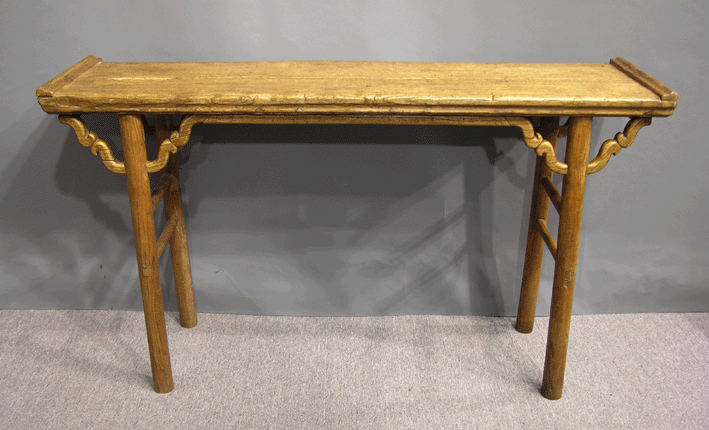
16th/17th C, Sophora (Huai), Shanxi. Shallow everted ends on top and round legs show Ming classical style,
31” h. 55” w. 14” d.
This recessed-leg table displays classic minimalism style characteristic of Ming Dynasty. It is constructed in the traditional mortis-and-tenon method. The top is made of one solid plank, with low everted flanges capping the ends. The wood on this plank has a very distinctive tangential deep grain pattern characteristic of the Sophora, a tree extinct by the end of the Ming period due to its extreme slow growth and over-used as favorite furniture-building material by literati and elite members of society of the time. This texture-look gives character to the table and needs no ornate decoration. The legs as well as the side stretchers are round, typical of table legs constructed in the Ming period. The spandrels are very simply designed.
Another characteristic of Ming furniture is the appearance of hand-hammered boss-head nails. They served more to show off value than for connecting joints as metal was expensive at that period. This kind of nails appeared as far back as Yuan Dynasty (1279-1368) but seldom after early Qing. By mid-Qing, more elaborate carvings and decorations were desired by the rising merchant class. So, these hand-hammered nails came to indicate the age of an item.
This altar table has characteristics favored by Ming literati, who were influenced by Confucius philosophy to live simply and to reduce artifice to a minimum. Dignity, simplicity of structure, and balance was the ideal of the day. Too much carving and elaborate decorations were considered vulgar. Today, this authentic ancient table is valuable as China does not allow relics to leave the country. This is a museum piece. As a matter of fact, one looking quite similar, of same size, grain pattern, and coloring was shown in a museum but is described as of huanghuali wood, a wood imported to China from Hainan Island off the south coast of China when Sophora wood became extinct. It was about mid-16th century when Chinese officials decided to lift the ban on maritime trade and began importing large quantities of tropical hardwoods to China. Huanphauli was one of them and became favored by the elite social class for furniture wood for its smoother grain and attractive yellow-reddish color. Huanphauli furniture today is highly valued by furniture collectors, but the rare, extinct sophora has greater value historically.